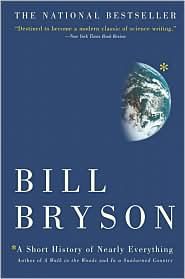This review contains affiliate links, which earn me a small commission when you click and purchase, at no extra cost to you. Thank you for supporting my small business and allowing me to continue providing you a reliable resource for clean book ratings.
The title of this book makes it sound rather daunting as a casual read. After working through the introduction, however, it quickly picks up speed and is a generally enjoyable book. But don’t expect speed in the sense of action-packed adventure and high-speed chases: rather, consider the speed created by the momentum of massive forces of nature coming together to form matter, then life, and finally, us. Do not be deceived: this is a book about science. But also do not be deterred. Unlike the science texts you were forced to swallow whole during grade school, this book maintains a steady pace and only provides enough science-y detail to help you grasp difficult concepts and make the necessary connections from one branch of science to another.
The beginning of the book takes on some of the biggest theories in the physical sciences, mostly surrounding the “Big Bang” theory and the creation of the universe as we more or less understand it now. The theories are palatably explained, and the book doesn’t dwell on any single concept for too long. Once the universe is sufficiently formed, the book moves into the particulars regarding our own planet. We are introduced to the elements, scientific measuring tools, Einstein’s major theories (along with his ideas that didn’t really take off), and subatomic particles.
After breezing through the particulars of particles, the book moves into the macro-events that shape our world. These events mostly consist of different ways our planet can explode, from beneath and from above. It’s quite exciting, in a nerdy sort of way. Once the earth has been roughly hewn into the form we know today, the book proceeds to explain the forces of nature and the huge helpings of luck that combined to usher in the creation of life. Cell theory and structure are explained in a format much more agreeable than any eighth-grade science text I have encountered. Darwin and his colleagues (and enemies) join the scene, and the final chapters of the book discuss the admittedly paltry evidence and scientific educated guesses surrounding our evolution from other forms of life.
The book’s structure is broken down nicely into short chapters so reading can be accomplished in small, edible bits, so as not to overwhelm the typical reader who hasn’t touched a science text since high school. The concepts are interesting, and I enjoyed the descriptions of squabbling and drama that accompany each major scientific breakthrough. As opposed to our school texts that merely present facts to be memorized for later regurgitation, this book presents a more realistic view of science: an ever-evolving set of ideas that only hold true until our understanding of the world and universe around us dramatically changes through some paradigm-shattering discovery. The only chapter I didn’t really care for was the final one, which suddenly veers into a discussion of how much death and destruction we create as human beings. Despite some superfluous authorial diatribe, the book ends well and leaves the reader feeling a little bit smarter.
Rated: Moderate. You will unexpectedly encounter one use of the “s” word near the beginning of the book, and then two instances of the “f” word later on. Apparently scientists sometimes get a little carried away explaining and defending their theories and let fly some rather un-scientific words.
Click here to purchase your copy of A Short History of Nearly Everything on Amazon.




